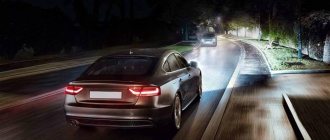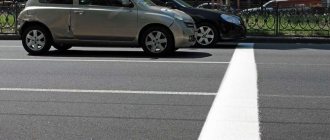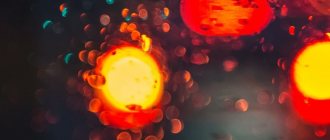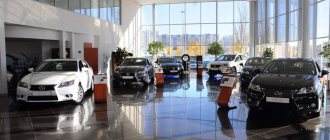A modern car has as many as 8 different lighting devices installed (there is also a backlight for the rear license plate, but in this case we are not interested in it). And we need to use these 7 lighting devices: headlights, flashlights, foglights and other things in different ways, depending on as many as 8 conditions. Let's list lighting devices and conditions for their use for 2021!
So, the car has so-called external lighting devices. These include:
- headlights: low beam;
- headlights: high beam;
- rear lights;
- fog lights (PTF);
- rear fog lights;
- parking lights;
- daytime running lights (DRLs).
And among the conditions for including certain lighting devices in the traffic rules, there are the following:
- daylight hours;
- dark time of day: illuminated road;
- dark time of day: unlit road;
- low visibility conditions;
- standing/moving car;
- trailer/towed vehicle;
- populated/non-populated area.
Are you scared? It's actually not all that scary. Let's find out when and in what cases you need to turn on the headlights, fog lights, high or low beam headlights and dimensions. Data current as of May 29, 2021. For convenience, we will consider the rules for using car lights depending on the time of day and other conditions, and answer some pressing questions. And at the end of the article we will provide a table as a simple way to remember when which lights need to be turned on on the car.
What devices are used during the day?
Despite the listed conditions, which may seem too many to you, everything is very simple and logical. Below we will consider each case of using a particular lighting device in accordance with the traffic rules relevant for March 2021.
The first thing to start with is, of course, the operating time of the machine. Let's look at each of them, as well as common questions that car owners sometimes have.
Daytime is the most active time of the day, which is associated with our lifestyle. During daylight hours, it is permissible to turn on daytime running lights, which can be replaced by fog lights or headlights with low beam. It’s probably worth clarifying that they should all work separately, you don’t need to turn them all on at once. If, for example, you do not have DRLs, then use low beams. You make the decision here yourself.
It is prohibited, according to traffic rules, to switch to high beams during the day, and it is also prohibited to drive with only one fog lights located at the rear turned on. It's simply not logical.
What devices are used at night?
It would be more correct, of course, to say “in the dark,” which is even defined in the traffic rules. Without going into too much detail, it’s just a time when it’s dark, at dusk in the morning or evening and at night.
Here headlights are used in high and low beam modes. If you are parked overnight (or if you are driving with a trailer, or are towed), then you need to switch to dimensions. In this case, the fog lights should not work separately; they are accompanied by high beam or low beam.
If you have a spotlight, do not use it if you are driving through a populated area or when you see an oncoming car. This is a traffic violation.
The rules establish a procedure that ensures the safety of all road users. Therefore, it is not allowed to blind oncoming drivers with high beams if the cars have approached more than 150 m. In addition, the oncoming driver may ask you to switch the mode of the lighting devices. This is usually done by “blinking” the headlights.
When moving around the territory of a well-lit populated area, they also do not use high beams. And, as in the situation with daytime mode, it is prohibited to use fog lights on a lit road without accompanying low or high beams. DRLs are also not turned on at night.
For movement through tunnels day and night, all of the above requirements apply.
External car lights
At the beginning of this article, a few words about what external lighting devices a car may have. This information is primarily intended for those who are studying at a driving school and do not yet understand what these or other headlights or lanterns are intended for.
Note. The topic “lighting devices” is one of the most difficult in a driving school, because... It is difficult for a driver candidate who has never driven before to remember the similar names of light devices and the rules for their use.
parking lights
Dimensions are small light devices located approximately at the corners of the car (4 pieces in total). They do not shine very brightly and are primarily designed so that drivers of other cars can understand in the dark where your car begins and ends.
As a rule, the car is designed in such a way that when you turn on the low or high beam headlights, the dimensions turn on automatically. That is, low beam without side lights does not work.
Daytime Running Lights
DRLs are light devices in the front of the car (2 pieces), which shine quite brightly. They are designed to improve visibility of the car from the front during daylight hours.
Daytime running lights should not be used at night because... at night, they can blind oncoming drivers due to their high brightness. However, they do not illuminate the road.
We recommend: Replacing the low beam bulb on a Lada Priora: 3 best brands and step-by-step replacement technology
In 2021, most cars are equipped with daytime running lights, but such lights are quite rare on cars manufactured before 2010.
Low and high beam headlights
Low beam (2 bulbs) and high beam (2 bulbs) headlights are the main lighting devices that are designed to illuminate the road in front of the car.
In this case, the low beam illuminates the area directly in front of the car, and the high beam illuminates a more distant area. It makes sense to use low beam at low speeds, high beam at higher speeds.
Fog lights
PTF - 2 headlights in the front bumper of a car, designed to illuminate the road in poor visibility conditions.
Fog lights are optional for 2021, so not all vehicle trim levels have them. That is, the car may not have PTF.
Fog light
Fog light - a red light at the rear of the vehicle, designed to improve visibility of the vehicle in poor visibility conditions. This light device is very bright and in good weather it can blind drivers of cars behind.
This lamp is required to be installed on all cars.
What light to use when visibility on the road is poor
For those who travel by car every day, the most common troublemakers are: morning fog, heavy snowfall, rain and twilight. To increase traffic safety, you can operate the headlights in both high beam and low beam modes. Here we would like to draw your attention to the fact that poor visibility due to weather and night time are different conditions, according to traffic regulations. Therefore, it is necessary to use high beams at night and in poor visibility conditions in accordance with established rules.
Poor visibility conditions are those that limit the driver's vision to less than 300 m ahead. If in such a situation you decide to stop driving, you can turn on the headlights together with the fog lights or low beam headlights. Or turn on the fog lights together with high or low beams plus rear fog lights.
Accordingly, it would be a violation to use fog lights without low or high beams, and this also includes included DRLs.
Hazard lights: what they are for and when to turn them on
The so-called “emergency light” is also a combination of the operation of several lighting devices, and therefore belongs to the section in the traffic regulations that regulates the use of various modes of operation of car headlights. What should you consider when activating the emergency alarm mode?
The very first thing is, of course, emergency situations in which not only emergency lights are involved, but also an emergency stop sign. The latter must always be in your trunk, otherwise you will violate traffic rules. Regardless of where the emergency breakdown of your car occurred, in a vacant lot or on the highway, you need to protect yourself and other road users by marking your car in accordance with the traffic rules. A warning triangle is installed on the route to your car 15 or 30 meters from it, depending on the location of the breakdown.
When can you use the emergency lights?
Hazard alarms are also considered a lighting device, and traffic regulations clearly regulate the possibility of their use. So, the emergency lights need to be turned on:
- if you get into an accident along with a warning triangle (2.5 traffic rules 7.1 traffic rules);
- if a situation arises where your car poses a danger;
- when forced to stop in a place where stopping is prohibited (together with an emergency stop sign);
- when towing on a towed vehicle;
- if you are blinded by oncoming traffic.
Hazard and other warning signals
If you are in tow, then turn on the hazard lights; if you are blinded by oncoming traffic and you have lost the ability to see something, immediately press the button. “Blinking headlights” helps to avoid such unpleasant moments. True, there are unscrupulous drivers who always leave their high beams on.
The rapid switching of headlights (high-low - low) is “blinking”. It is also used in cases when you want to overtake the car in front. The popular use of this mode helps warn other drivers about an imminent meeting with traffic police officers.
Thanks for subscribing!
You won't find an official justification for "blinking" anywhere, but this is not a case where something is allowed that is not prohibited. You may well be fined for such actions, imputed to a violation of traffic regulations regarding the operation of headlights.
What you need to remember from the traffic rules about the use of different modes of lighting devices. Clauses 1 and 2 of Article 19
All norms and rules are regulated in Article No. 19, which fully helps the driver answer questions regarding the operating modes of vehicle lighting devices in different conditions and situations.
Remember that the same rules apply in the tunnel as for the dark. As soon as you enter it, turn on your headlights. If you drive a bicycle or are lucky enough to have the experience of driving a horse-drawn cart, then provide your vehicle with a flashlight. But don’t forget about the dimensions if you:
- Are you the driver of a towed vehicle?
- Traveling with a trailer
Due to traffic regulations and simple respect for other road users, switch to low beams at the request of the driver of an oncoming car or without it. Blinding a driver coming towards you can lead to quite serious consequences not only for him, but also for you. Also, do not blind fellow travelers driving in front of you, because the headlights are reflected in the observation mirror and also impair traffic safety. If you haven’t thought about it, pay attention to whether the vehicle ahead has turned on its emergency lights.
What color of side lights is allowed according to traffic regulations?
If the color of the light device does not meet the standard requirements established for the type of vehicle, the traffic regulations prohibit the operation of such a vehicle.
Requirements for external lighting of vehicles are established by GOST 8769-75. The terms of the standard determine that the front dimensions must emit a white color, and the rear dimensions must emit a red color (Clause 2.5.6).
We recommend: Checking/adjusting the ignition timing
Requirements for the color of side markers are established by GOST R 41.91-99: it must be yellow.
The rules specified in paragraphs 3-5 of Article 19
When parking or stopping, according to paragraph 3, at night, when driving along a poorly lit highway or in a situation where visibility drops to 300 m, you simply need to use red side lights. In the latter case, it is permissible to accompany the operation of the side headlights with low beam and fog lights, front or rear.
More precise rules regarding fog lights are discussed in paragraph 4 of the current rules. If you find yourself in a situation in which visibility is significantly reduced due to weather conditions, then turn on the fog lights and, along with them, low or high beams. This also applies to driving on an unlit road at night.
According to point 5, in the daytime, no matter where you are driving, in the city or on the highway, when visibility is good, the DRLs or headlights should always be on in low beam mode.
Rules for using external lighting devices at night
At night, or the dark time of the day, the rules refer to the period of time between the end of the evening and the beginning of the morning twilight. In such conditions, it is mandatory to turn on the headlights and side lights.
The choice of low or high beam depends on the following nuances:
- If you are driving along illuminated roads in a populated area , you cannot use high beams, only low beams.
- When approaching a vehicle moving in the oncoming lane, the high beams should be switched to low beams at least 150 meters in advance - this way you will not blind the other driver. It’s even better to switch at 200-250 meters.
- If an oncoming vehicle signals by switching or flashing its headlights at a greater distance , turn off the high beams. In such situations, your headlights are most likely poorly adjusted, and they do not so much illuminate the road as they shine into the eyes of oncoming drivers.
- You also need to switch the lights in other situations when there is a threat of blinding other drivers , both oncoming and passing.
What to do if you are blinded? The main thing is not to change lanes, otherwise there is a risk of getting into an accident, hitting a pedestrian or falling into a ditch. The rules require in such a situation to turn on the hazard warning lights, gradually reduce speed and, if necessary, stop.
We recommend: Installing an electronic catalytic converter in a car service center
Forced stop in the dark - be sure to turn on the side lights and, if desired, supplement them with low beams and fog lights.
Rules of paragraphs 6 and 7 of Article 19
Rotating lighting devices (called a spotlight or searchlight) are turned on, according to paragraph 6, only outside the city or other populated area and only when there is no oncoming traffic. The exception is specialized vehicles moving around the territory of a populated area with flashing blue lights, accompanied by sound signals established by the rules. This vehicle must move in the direction of the object that is the reason for the performance of the official task, which is determined to be urgent.
Paragraph 7 specifies the rules for operating rear fog lights. They are turned on if necessary to reduce an emergency situation in conditions of poor visibility on the road. A ban is imposed on connecting this lighting equipment to brake lights.











